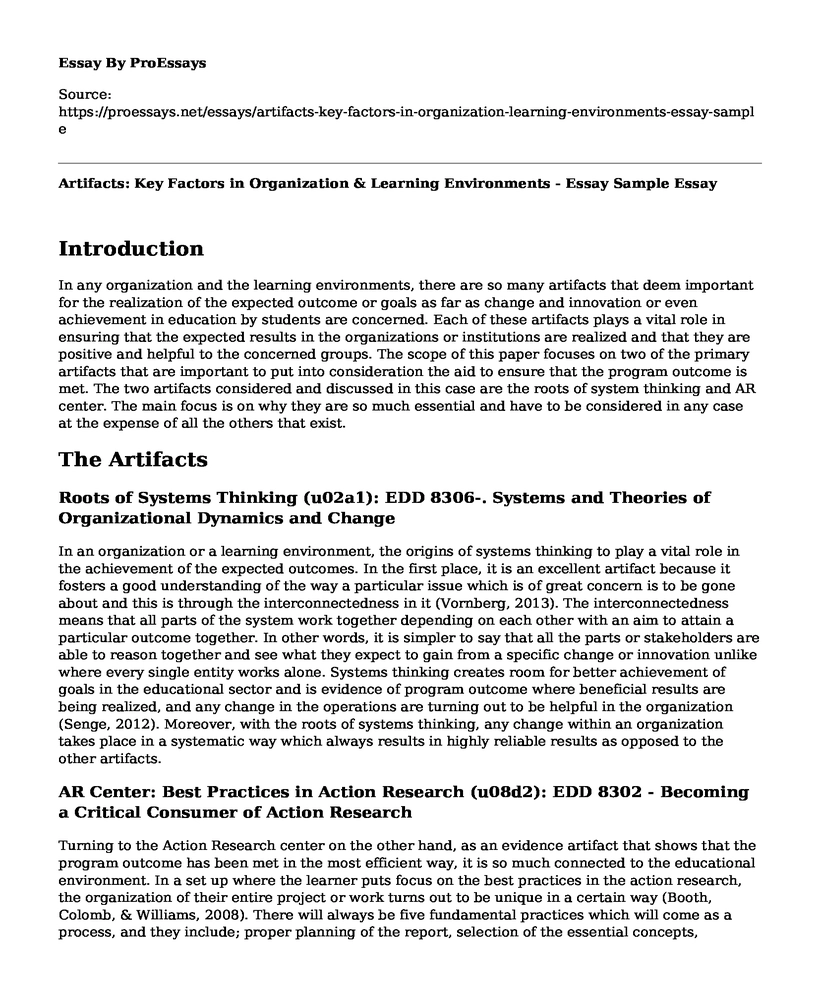Introduction
In any organization and the learning environments, there are so many artifacts that deem important for the realization of the expected outcome or goals as far as change and innovation or even achievement in education by students are concerned. Each of these artifacts plays a vital role in ensuring that the expected results in the organizations or institutions are realized and that they are positive and helpful to the concerned groups. The scope of this paper focuses on two of the primary artifacts that are important to put into consideration the aid to ensure that the program outcome is met. The two artifacts considered and discussed in this case are the roots of system thinking and AR center. The main focus is on why they are so much essential and have to be considered in any case at the expense of all the others that exist.
The Artifacts
Roots of Systems Thinking (u02a1): EDD 8306-. Systems and Theories of Organizational Dynamics and Change
In an organization or a learning environment, the origins of systems thinking to play a vital role in the achievement of the expected outcomes. In the first place, it is an excellent artifact because it fosters a good understanding of the way a particular issue which is of great concern is to be gone about and this is through the interconnectedness in it (Vornberg, 2013). The interconnectedness means that all parts of the system work together depending on each other with an aim to attain a particular outcome together. In other words, it is simpler to say that all the parts or stakeholders are able to reason together and see what they expect to gain from a specific change or innovation unlike where every single entity works alone. Systems thinking creates room for better achievement of goals in the educational sector and is evidence of program outcome where beneficial results are being realized, and any change in the operations are turning out to be helpful in the organization (Senge, 2012). Moreover, with the roots of systems thinking, any change within an organization takes place in a systematic way which always results in highly reliable results as opposed to the other artifacts.
AR Center: Best Practices in Action Research (u08d2): EDD 8302 - Becoming a Critical Consumer of Action Research
Turning to the Action Research center on the other hand, as an evidence artifact that shows that the program outcome has been met in the most efficient way, it is so much connected to the educational environment. In a set up where the learner puts focus on the best practices in the action research, the organization of their entire project or work turns out to be unique in a certain way (Booth, Colomb, & Williams, 2008). There will always be five fundamental practices which will come as a process, and they include; proper planning of the report, selection of the essential concepts, excellent implementation of the plan, and a severe review of the outcome and evaluation of the final result (Stringer, 2014). With the above in place, it is clear that all the program outcomes are met since there is a good organization of the process that works towards the achievement of this.
Conclusion
In conclusion, the two artifacts which are AR Center: Best Practices in Action Research (u08d2): EDD 8302 - Becoming a Critical Consumer of Action Research and Roots of Systems Thinking (u02a1): EDD 8306-. Systems and Theories of Organizational Dynamics and Change are so much, and thus there is a need to give them the first priority in any case where a change or innovation is being introduced since they will always lead to a logical flow of the essential processes and hence realization of the intended outcome.
References
Booth, W. C., Colomb, G. G., & Williams, J. M. (2008). The Craft of Research (3rd Ed.). Chicago, IL: University of Chicago Press.
Stringer, E, T. (2014). Action research. (4th Ed.). Library of Congress in Publication Data: Sage.
Senge, P. M., Cambron-McCabe, N., Lucas, T., Smith, B., Dutton, J., & Kleiner, A. (2012). Schools that learn: A fifth discipline field book for educators, parents, and everyone whocares about education. New York, NY: Crown Business.
Vornberg, J. A. (2013). Chapter 67: Systems theory. In Irby, B. J., Brown, G., Lara-Alecio, R., & Jackson, S. (Eds.), the Handbook of Educational Theories (pp. 805-813). Charlotte, NC: Information Age Publishing.
Cite this page
Artifacts: Key Factors in Organization & Learning Environments - Essay Sample. (2023, Jan 29). Retrieved from https://proessays.net/essays/artifacts-key-factors-in-organization-learning-environments-essay-sample
If you are the original author of this essay and no longer wish to have it published on the ProEssays website, please click below to request its removal:
- Nurses as Leaders in Healthcare Reform. Essay Example
- Fitbit VRIO Analysis Paper Example
- General Electric Company Case Study Paper Example
- Paper Example on Johnson & Johnson: Medical Devices, Baby Products & More
- Paper Example on Quality Control: The Foundation for Achieving Consumer Satisfaction
- Essay Sample on Mental Health of the Indigenous Women
- Sabre's E-D.W.: Exec. Dashboards for Performance Metrics & Org. Relevance - Essay Sample







